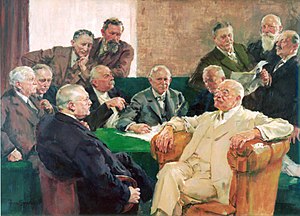
Walther Rathenau was a German industrialist, writer and liberal politician.
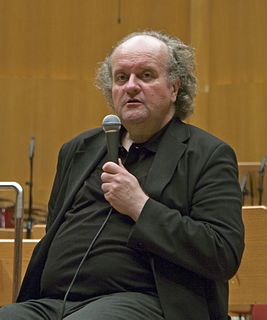
Wolfgang Rihm is a German composer and academic teacher. He is musical director of the Institute of New Music and Media at the University of Music Karlsruhe and has been composer in residence at the Lucerne Festival and the Salzburg Festival. He was honoured as Officier of the Ordre des Arts et des Lettres in 2001. His musical work includes more than 500 works. In 2012, The Guardian wrote: "enormous output and bewildering variety of styles and sounds".

Martin Sigismund Eduard von Simson was a German jurist and distinguished liberal politician of the Kingdom of Prussia and German Empire, who served as President of the Frankfurt Parliament as well as the first President of the German Parliament and of the Imperial Court. He was ennobled by Kaiser Frederick III in 1888.

Meret Elisabeth Oppenheim was a German-born Swiss Surrealist artist and photographer.
The Verein für Socialpolitik, or the German Economic Association, is an important society of economists in the German-speaking area.

Tell Halaf is an archaeological site in the Al Hasakah governorate of northeastern Syria, a few kilometers from the city of Ra's al-'Ayn near the Turkish border. The site, which dates to the 6th millennium BCE, was the first to be excavated from a Neolithic culture, later called the Halaf culture, characterized by glazed pottery painted with geometric and animal designs.

Anton Alexander von Werner was a German painter known for his history paintings of notable political and military events in the Kingdom of Prussia. One of the most famous painters of his time, he is regarded a main protagonist of the Wilhelmine Period.
Fabian Ludwig Georg Adolf Kurt von Schlabrendorff was a German jurist, soldier, and member of the German resistance against Adolf Hitler. From 1967 to 1975 he was a judge of the German Federal Constitutional Court.
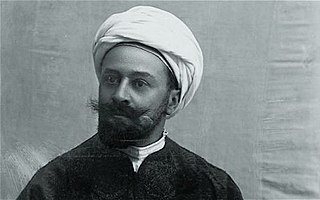
Baron Max von Oppenheim was a German lawyer, diplomat, ancient historian, and archaeologist. He was a member of the Oppenheim banking dynasty. Abandoning his career in diplomacy, he discovered the site of Tell Halaf in 1899 and conducted excavations there in 1911–13 and again in 1927–29. Bringing many of his finds to Berlin, he exhibited them in a private museum in 1931. This was destroyed by Allied bombing in World War II. However, most of the findings were recently restored and have been exhibited again at Berlin and Bonn.

Karl Friedrich Lessing was a German historical and landscape painter, grandnephew of Gotthold Ephraim Lessing and one of the main exponents of the Düsseldorf school of painting.

Walter Rudolf Leistikow (1865–1908) was a German landscape painter, graphic artist, designer and art critic.
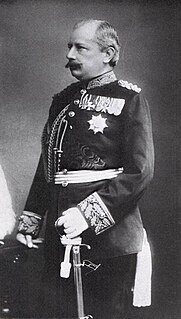
Karl August, Hereditary Grand Duke of Saxe-Weimar-Eisenach was a German prince and Hereditary Grand Duke (Erbgroßherzog) of Saxe-Weimar-Eisenach.
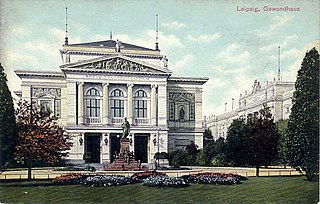
Martin Carl Philipp Gropius was a German architect.

The Mendelssohn family are the descendants of Mendel of Dassau. The German Jewish philosopher Moses Mendelssohn and his brother Saul were the first to adopt the surname Mendelssohn. The family includes his grandson, the composer Felix Mendelssohn and his granddaughter, the composer Fanny Mendelssohn.

Waldfriedhof Zehlendorf is a cemetery located in Berlin's Nikolassee district. The cemetery occupies an area of 376,975 m2. An additional Italian war cemetery was created there in 1953. A number of notable people of Berlin are buried at the cemetery; some have a grave of honor. In particular, all of Berlin's deceased post-war mayors are buried here.
Hans Friedrich Wilhem Ernst von Raumer was a German politician of the German People's Party (DVP). He served as minister in two governments of the Weimar Republic and was also active as a representative of German industry.

The Wittgenstein family is a German-Austrian family that rose to prominence in 19th and 20th century Vienna, Austria. The family was originally Jewish and originated from the Wittgensteiner Land in Siegen-Wittgenstein, Germany.
Richard Fester was a German historian.
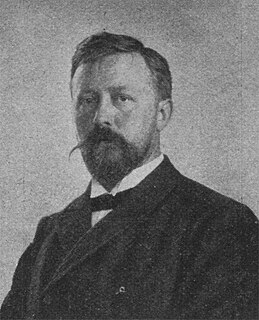
Friedrich Kallmorgen was a German Impressionist painter who specialized in landscapes and cityscapes.
Ernst-Lothar von Knorr was a German composer, music educator and civil servant.
